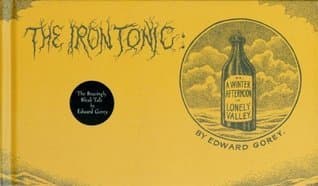
Book Review Summary: The Iron Tonic: Or, A Winter Afternoon in Lonely Valley
Introduction
"The Iron Tonic: Or, A Winter Afternoon in Lonely Valley" by Edward Gorey is a mysterious and enigmatic book that leaves readers questioning its purpose. With its gloomy atmosphere and intriguing title, this book has garnered a mix of opinions from readers. In this article, we will delve into the author's background, analyze the common views of readers, and explore the reasons for both recommending and not recommending this book.
About Edward Gorey
Edward Gorey, the author of "The Iron Tonic," was born in Chicago and came from a colorful family. His parents divorced when he was 11, and he later remarried when he was 27. Gorey's step-mother, Corinna Mura, had a brief role in the classic film "Casablanca." His father was a journalist, and his maternal great-grandmother, Helen St. John Garvey, was a popular 19th-century greeting card writer/artist. Gorey studied art for one semester at The School of The Art Institute of Chicago and became a professional illustrator. He illustrated works as diverse as "Dracula" by Bram Stoker, "The War of the Worlds" by H.G. Wells, and "Old Possum's Book of Practical Cats" by T.S. Eliot. Gorey's illustrations for children's books by John Bellairs and his own series of books have made him a beloved figure in the world of literature and art.
Analysis of Views
-
Gloomy and Surreal: Readers describe "The Iron Tonic" as a gloomy little book with eels, infant death, and obscure objects falling. The book's atmosphere is dark and tormented, which some attribute to Gorey's childhood experiences. However, Gorey himself claimed that his childhood was perfectly normal and happy. Despite the gloom, his humor rescues readers from despair.
-
Victorian Aesthetic: The book's title, "Iron Tonic," is not mentioned in the text itself. Some readers speculate about the significance of the title and why it appears only in the title and not in the text. Others question the presence of the Iron Tonic in the title and dedication to Gorey's great-grandmother, Helen St. John Garvey. Gorey's attachment to a Victorian aesthetic is explored, as he finds inspiration in the stiffness of Victorian ideals of propriety. This aesthetic serves as a foil for his particular sense of humor.
-
Mysterious Title: The book's title raises questions about its meaning and relevance to the content. Some readers find it confusing or misleading, as it suggests a connection to medicine or a tonic that is not present in the story. Others appreciate the playfulness of the title and its connection to Victorian quackery.
-
Illustrations: Gorey's illustrations in "The Iron Tonic" are praised for their intricate detail and dark beauty. Readers appreciate the contrast between the bleak text and the visually striking images that enhance the atmosphere of the story. The illustrations are often described as haunting and evocative, adding depth to the overall experience of reading the book.
-
Humor: Despite its gloomy themes, "The Iron Tonic" is lauded for its humor. Gorey's ability to inject humor into dark situations is a hallmark of his work. Readers find his wit and irony refreshing and enjoy the moments of levity amidst the despair.
Reasons for Recommendation
-
Gorey's Unique Style: Edward Gorey's distinctive style, characterized by his gloomy atmosphere, surrealism, and morbid humor, has attracted fans worldwide. Readers recommend "The Iron Tonic" for its ability to transport them into a world where darkness and humor coexist in unexpected ways.
-
Intriguing Title: Although some readers find the title confusing or misleading, others appreciate its mysterious quality. The book's title piques their curiosity and encourages them to explore its enigmatic nature. This element adds an extra layer of intrigue to the reading experience.
-
Illustrations: Gorey's intricate illustrations are a major draw for readers who appreciate detailed artwork. The illustrations in "The Iron Tonic" are praised for their beauty and ability to enhance the atmosphere of the story. They add depth and visual interest to an otherwise text-heavy book.
Reasons for Not Recommendation
-
Lack of Plot: Some readers find "The Iron Tonic" lacking in a clear plot or narrative structure. The absence of a detailed plot may leave readers feeling lost or unsure about the purpose or direction of the story. This lack of structure can be a turn-off for those who prefer more conventional storytelling methods.
-
Dark Themes: The book's dark themes, including infant death, eels, and isolated individuals in a haunted sanitarium, may not appeal to readers who prefer lighter or more uplifting content. The gloomy atmosphere can be overwhelming for some readers, making it challenging to fully enjoy the book's unique style and humor.
Conclusion
"The Iron Tonic: Or, A Winter Afternoon in Lonely Valley" by Edward Gorey is a book that evokes a sense of mystery and enigma with its gloomy atmosphere and intriguing title. While some readers appreciate its unique style, dark humor, and intricate illustrations, others find it lacking in plot structure or struggle with its dark themes. Ultimately, whether or not you recommend this book depends on your personal preference for gloomy tales with morbid humor or if you seek more conventional narratives with clear plot structures. Regardless, Edward Gorey's distinctive style has left an indelible mark on the world of literature and art, making him a beloved figure among fans of his work.